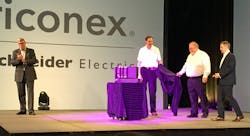Kicking off their Global Automation Conference in Dallas this week, Schneider Electric executives were excited to finally get to tell the public about the new offering they’ve had in the works for almost two years. Tricon CX is a compact version of the company’s Triconex line of safety-instrumented systems, geared toward high-hazard industrial processes. It not only transfers the capabilities of the existing system to a smaller, lighter, less power-hungry product, but also introduces advanced capabilities and performance.
“It’s the first real big change that we’ve made in at least 15 years, maybe even longer than that,” said Gary Freburger, president of the Industrial Automation division at Schneider Electric, during a press briefing on the eve of the announcement.
“It’s definitely the most exciting announcement and launch we’ve done in 15, maybe 16, years with Triconex,” echoed Mike Chmilewski, vice president of process systems offer management for Schneider Electric’s process automation business, adding, “It has a number of improvements that we think are going to be profound in the marketplace.”
Geared toward the oil and gas, power, refining, chemicals, pharmaceutical and biotech industries, where safe and reliable operations are critical, Tricon CX protects against inherent risk and hazards, from both a safety and security standpoint.
The compact Tricon CX is 50 percent smaller than its predecessor, and 67 percent lighter. It comes with several performance upgrades as well, including increased response time for critical applications, extended operational time even under fault conditions, more changes possible without halting operations, and online upgrades operational interruption. “We turned up the performance, we advanced the capabilities, and we increased the value of ownership,” said Steve Elliott, senior offer director for Schneider Electric’s process automation offerings.
Advanced monitoring and control capabilities, and advanced productivity tools, have come about in part through increased R&D spending. Company executives have made several references over the past couple days of meetings to the acquisition of Invensys by Schneider Electric about a year and a half ago, in most cases positive, including in relation to R&D. Invensys had already been building its R&D investment, and is today spending more than double what it was four to five years ago, according to Chmilewski. “There was speculation that Schneider would cut back the spending,” he said. “The only thing they asked us to do was go faster.”
The new safety system has also earned the first joint certification from TUV for both functional safety and security. “It’s extremely important to have a joint certification,” Chmilewski said, noting the importance of safety and security really working together. “Safety and security have always been a top concern for our industrial clients, but now new threats, such as cyber attack, have challenged the traditional approaches they have taken to protect and secure their people, property, communities and the environment.”
System space and weight can be an important factor in process industries for a number of reasons. The oil and gas industry, for example, is facing considerable limitations on its offshore rigs. “We’re doing everything we can to reduce footprint, which is a different consideration than we had just a few years ago,” said Chris Lyden, senior vice president of business development for the Industrial Automation division of Schneider Electric.
Elliott pointed to an example of a plant designed by an EPC. Designed primarily for cost and schedule, it had about 50 protection layers build in for safety. Five years later, as the owner/operator began upgrading with operational integrity more top of mind, they ended up with three times the number of protection layers.
“Now they’ve got to fit some new stuff in, and space became a big driver,” Elliott said. “With the new compact form factor, they can expand in place.”
As the company also celebrates a billion hours of running Triconex systems without a failure on demand, it’s important to understand that Schneider Electric has used proven circuitry in its new design, Lyden said. “There’s a lot of emphasis in industry about proven-in-use in safety systems, as you’d expect,” he said. “We took Tricon circuits, and built them into ASICs. We didn’t recreate the wheel. We just used modern technology to make those circuits smaller, and manufacture them more cost-effectively.”

